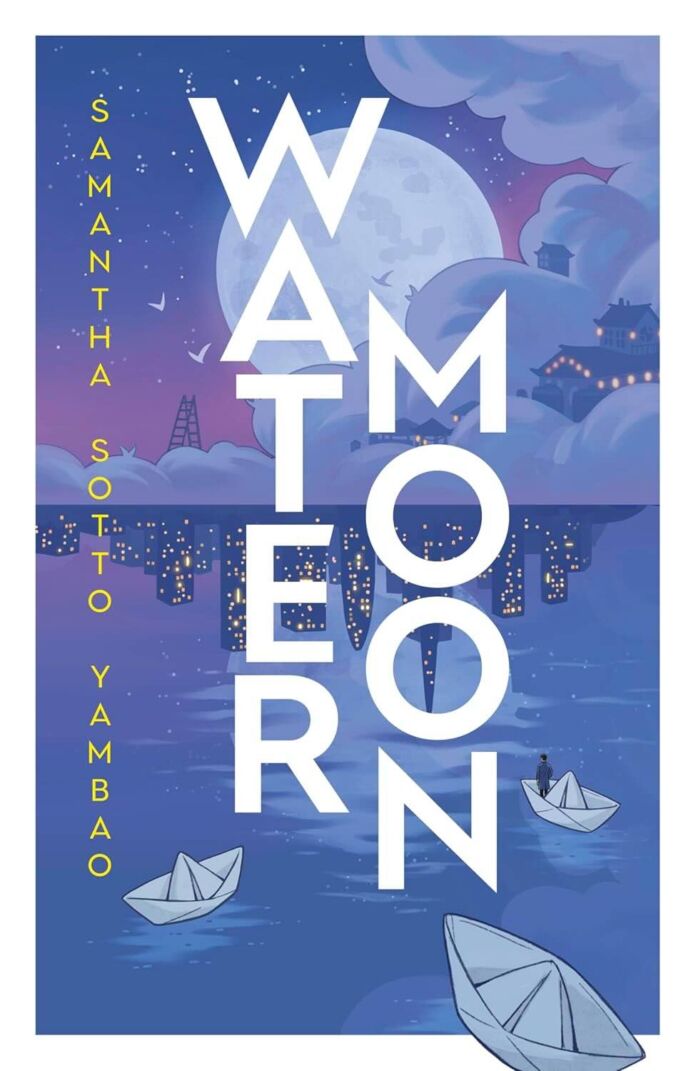In Water Moon, Samantha Sotto Yambao crafts an extraordinary fusion of magical realism and Japanese mythology that explores the weight of destiny and the power of choice. The novel follows Hana Ishikawa, who inherits a mysterious pawnshop where people can trade their regrets for peace of mind. When she discovers the shop ransacked and her father missing, she embarks on an enchanting journey through a parallel world with an unlikely companion—a physicist from our reality named Keishin.
Worldbuilding and Atmosphere
Yambao’s creation of two intertwining worlds is masterfully executed. The magical realm she constructs feels both ancient and immediate, with locations that capture the imagination:
- A temple where prayers materialize as whispers
- A train station where people wait lifetimes for their destined journey
- A night market floating in the clouds
- A library where lost things find their home
The author’s attention to detail in crafting these magical spaces creates an immersive experience that feels both fantastical and grounded in emotional truth.
Writing Style and Prose
The prose is elegant and evocative, with a dreamlike quality that perfectly suits the story’s supernatural elements. Yambao has a particular talent for sensory details that bring scenes to life:
“Time has no borders except those people make. On this particularly cold autumn day, Ishikawa Hana fashioned that border out of the thinnest layer of skin.”
Her writing style balances poetic description with forward momentum, though occasionally the metaphorical language becomes slightly overwrought, particularly in some of the more contemplative passages.
Character Development
Hana Ishikawa
The protagonist’s journey from duty-bound pawnshop heir to someone questioning the very foundation of her world is compelling and well-realized. Her internal struggle between fate and free will forms the emotional core of the novel.
Keishin
As the outsider who challenges Hana’s worldview, Keishin serves as both love interest and catalyst for change. His scientific background provides an interesting counterpoint to the magical elements, though occasionally his acceptance of the supernatural feels a bit too quick.
Supporting Characters
The secondary characters are richly drawn, particularly:
- Toshio (Hana’s father) – whose complicated motivations drive much of the plot
- Haruto – whose tragic fate adds emotional depth to the story
- The Shiikuin – whose menacing presence creates genuine tension
Themes and Symbolism
The novel explores several interconnected themes with sophistication:
- Choice vs. Destiny
- The tension between predetermined fate and free will
- The cost of breaking from prescribed paths
- The weight of responsibility versus personal desire
- Identity and Belonging
- The struggle between duty and personal fulfillment
- The question of what makes a soul complete
- The search for authentic self in a world of prescribed roles
- Love and Sacrifice
- The price of true connection
- The strength required to choose love over duty
- The power of sacrifice in transforming both individuals and societies
Plot Structure and Pacing
The novel’s structure is intricate but well-managed, alternating between present-day action and revealing flashbacks. The pacing is generally strong, though it occasionally slows in the middle sections where world-building details threaten to overwhelm the narrative momentum.
Cultural Elements and Authenticity
Yambao’s integration of Japanese cultural elements and mythology feels respectful and well-researched. The novel’s magical system draws from traditional concepts while creating something uniquely its own. The author’s handling of cultural elements adds depth without falling into exoticism.
Areas for Improvement
While the novel is largely successful, there are some aspects that could be stronger:
- Some of the rules governing the magical world feel inconsistent
- The resolution of certain plot threads feels rushed
- A few supporting characters could be more fully developed
- The scientific elements sometimes clash with the magical tone
Comparison to Other Works
Fans of Erin Morgenstern’s The Night Circus or Haruki Murakami’s magical realist works will find familiar elements here, though Yambao’s voice is distinctly her own. The novel builds on themes explored in her previous works (Before Ever After, Love and Gravity) while reaching new heights of imaginative storytelling.
Target Audience
This novel will particularly appeal to readers who enjoy:
- Magical realism with cultural depth
- Romance with philosophical undertones
- Stories about destiny and free will
- Japanese-influenced fantasy
- Character-driven supernatural fiction
Final Assessment
Water Moon by Samantha Sotto Yambao is an ambitious and largely successful blend of fantasy, romance, and philosophical exploration. Despite some minor flaws, the novel’s unique premise, strong characterization, and beautiful prose make it a standout in the genre.
Strengths
- Imaginative worldbuilding
- Strong emotional core
- Beautiful prose
- Complex themes
- Unique magical system
Impact and Lasting Impression
Water Moon by Samantha Sotto Yambao leaves readers contemplating their own choices and the nature of destiny long after the final page. It’s a reminder that sometimes the most magical stories are those that help us see our own world in a new light.
The novel succeeds not just as a fantasy romance but as a meditation on the nature of choice, regret, and the courage required to forge our own path. While it may not be perfect, its flaws are overshadowed by its ambition and heart.
For readers seeking a unique blend of magical realism, romance, and philosophical depth, Water Moon offers a compelling journey through both physical and emotional landscapes. It’s a testament to the power of choice and the unexpected ways love can transform us.





